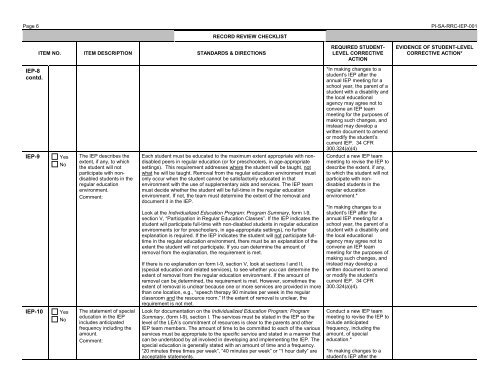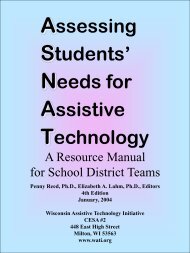procedural compliance self-assessment - The Special Education Team
procedural compliance self-assessment - The Special Education Team
procedural compliance self-assessment - The Special Education Team
Create successful ePaper yourself
Turn your PDF publications into a flip-book with our unique Google optimized e-Paper software.
Page 6 PI-SA-RRC-IEP-001<br />
IEP-8<br />
contd.<br />
RECORD REVIEW CHECKLIST<br />
ITEM NO. ITEM DESCRIPTION STANDARDS & DIRECTIONS<br />
IEP-9 Yes<br />
No<br />
IEP-10<br />
Yes<br />
No<br />
<strong>The</strong> IEP describes the<br />
extent, if any, to which<br />
the student will not<br />
participate with nondisabled<br />
students in the<br />
regular education<br />
environment.<br />
Comment:<br />
<strong>The</strong> statement of special<br />
education in the IEP<br />
includes anticipated<br />
frequency including the<br />
amount.<br />
Comment:<br />
Each student must be educated to the maximum extent appropriate with nondisabled<br />
peers in regular education (or for preschoolers, in age-appropriate<br />
settings). This requirement addresses where the student will be taught, not<br />
what he will be taught. Removal from the regular education environment must<br />
only occur when the student cannot be satisfactorily educated in that<br />
environment with the use of supplementary aids and services. <strong>The</strong> IEP team<br />
must decide whether the student will be full-time in the regular education<br />
environment. If not, the team must determine the extent of the removal and<br />
document it in the IEP.<br />
Look at the Individualized <strong>Education</strong> Program: Program Summary, form I-9,<br />
section V, “Participation in Regular <strong>Education</strong> Classes”. If the IEP indicates the<br />
student will participate full-time with non-disabled students in regular education<br />
environments (or for preschoolers, in age-appropriate settings), no further<br />
explanation is required. If the IEP indicates the student will not participate fulltime<br />
in the regular education environment, there must be an explanation of the<br />
extent the student will not participate. If you can determine the amount of<br />
removal from the explanation, the requirement is met.<br />
If there is no explanation on form I-9, section V, look at sections I and II,<br />
(special education and related services), to see whether you can determine the<br />
extent of removal from the regular education environment. If the amount of<br />
removal can be determined, the requirement is met. However, sometimes the<br />
extent of removal is unclear because one or more services are provided in more<br />
than one location, e.g., “speech therapy 90 minutes per week in the regular<br />
classroom and the resource room.” If the extent of removal is unclear, the<br />
requirement is not met.<br />
Look for documentation on the Individualized <strong>Education</strong> Program: Program<br />
Summary, (form I-9), section I. <strong>The</strong> services must be stated in the IEP so the<br />
level of the LEA’s commitment of resources is clear to the parents and other<br />
IEP team members. <strong>The</strong> amount of time to be committed to each of the various<br />
services must be appropriate to the specific service and stated in a manner that<br />
can be understood by all involved in developing and implementing the IEP. <strong>The</strong><br />
special education is generally stated with an amount of time and a frequency.<br />
“20 minutes three times per week”, “40 minutes per week” or “1 hour daily” are<br />
acceptable statements.<br />
REQUIRED STUDENT-<br />
LEVEL CORRECTIVE<br />
ACTION<br />
*In making changes to a<br />
student’s IEP after the<br />
annual IEP meeting for a<br />
school year, the parent of a<br />
student with a disability and<br />
the local educational<br />
agency may agree not to<br />
convene an IEP team<br />
meeting for the purposes of<br />
making such changes, and<br />
instead may develop a<br />
written document to amend<br />
or modify the student’s<br />
current IEP. 34 CFR<br />
300.324(a)(4)<br />
Conduct a new IEP team<br />
meeting to revise the IEP to<br />
describe the extent, if any,<br />
to which the student will not<br />
participate with nondisabled<br />
students in the<br />
regular education<br />
environment.*<br />
*In making changes to a<br />
student’s IEP after the<br />
annual IEP meeting for a<br />
school year, the parent of a<br />
student with a disability and<br />
the local educational<br />
agency may agree not to<br />
convene an IEP team<br />
meeting for the purposes of<br />
making such changes, and<br />
instead may develop a<br />
written document to amend<br />
or modify the student’s<br />
current IEP. 34 CFR<br />
300.324(a)(4).<br />
Conduct a new IEP team<br />
meeting to revise the IEP to<br />
include anticipated<br />
frequency, including the<br />
amount, of special<br />
education.*<br />
*In making changes to a<br />
student’s IEP after the<br />
EVIDENCE OF STUDENT-LEVEL<br />
CORRECTIVE ACTION*











